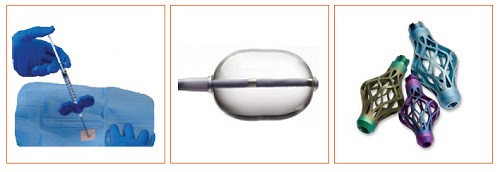Vertebral compression fractures (VCFs) occur when the bony block or vertebral body in the spine collapses, which can lead to severe pain, deformity and loss of height. These fractures more commonly occur in the thoracic spine (the middle portion of the spine), especially in the lower part.These spinal fractures occur in nearly 700,000 patients each year. They are almost twice as common as other fractures typically linked to osteoporosis, such as broken hips and wrists.
Vertebral compression fractures (VCFs) of the spinal column are usually considered stable and do not require surgical instrumentation.But sometimes, surgical intervention is necessary.
There are many different procedures:

- Vertebroplasty is usually an outpatient procedure that takes one to two hours where under guided imaging, a needle get inserted into the vertebral body and cement is injected. This cement hardens quickly and stabilizes the fracture.
- Kyphoplasty is a very similar procedure. Balloon Kyphoplasty uses orthopaedic balloons to restore vertebral height and correct angular deformity from vertebral compression fractures (VCF) due to osteoporisis, cancer, or benign lesion. After reduction, the balloons are deflated and removed. The resulting cavity (void) allows for a controlled deposition of Kyphon bone cement — which helps form an internal cast and stabilize the fracture. The most relevant companies focused on this technique are: Medtronic (Kyphon), Joline, Tsunami Medical and Zavation (ZVplasty).
- Kyphoplasty Double Balloon:
- Internal fixation and stabilization using an Expandable titanium implant: Osteoporotic vertebral compression fracture (VCF) treatments has focused primarily on pain management. The Expandible titanium implants (Spine Jack, OsseoFix) focus on restore the anatomy and protect the patients from adjacent level fractures.
- OsseoFix Spinal System (Alphatec): OsseoFix Procedure VIDEO
- Spine Jack: Stryker (Vexim): Spine Jack Procedure VIDEO

- Unipedicular PEEK implant-based treatment solution for VCFs: The Kiva (IZI Medical) comprises a special delivery tool that first positions a guidewire inside the vertebra that coils up into a helix. The actual implant, made from the now popular PEEK-OPTIMA biocompatible polymer, is then pushed over the guidewire. The guidewire is then withdrawn and bone cement is injected into the implant. Because less cement is used due to the implant taking up much of the volume, there is a lower incidence of cement leakage.Kiva Procedure VIDEO
- Pedicular PEEK polymer implants: V-STRUT (Hyprevention) features a pedicle anchorage designed to distribute vertebral load between anterior and posterior columns to reduce subsequent and adjacent fractures. The device adapts to bone stiffness and is combined with PMMA bone cement for fracture fixation, implanted in percutaneous minimally invasive procedure. V-STRUT Procedure VIDEO
- Biologic cementless technology: The OsteoPearl implants (Lenoss Medical) , with flexible links between the pearls, consist of 100% cortical bone, designed to create a 3-D Cortical Structural Matrix for immediate stability while introducing both osteoinductive and osteoconductive properties. Intended to directly stabilize the damaged vertebrae while delivering healing technology for the long-term healing of the spine.This stimulates healing and bone growth, for the long-term health of the patient, while avoiding all the complications associated with traditional cement. OsteoPearl VIDEO
